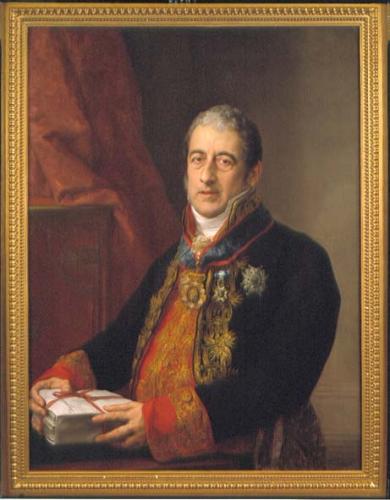Vicente Lopez
Place Born
ValenciaPlace Died
MadridBio
Displaying a precocious talent, the thirteen year old Lopez was entered by his grandfather, an artist of modest skills but good judgment, as a student in the Academy of San Carlos in Valencia. Having obtained a first prize for painting at the age of seventeen, he was accepted as a pupil at the Academy of San Fernando in Madrid, where he was soon exposed to the art of Mengs and Francisco Bayeu, while studying under Mariano Salvador Maella and Gregorio Ferro. It was the German Mengs, however, who exercised the most lasting influence, giving Lopez a love of specificity in costume and attention to detail that is one of the most obvious characteristics of his style.
His earliest surviving work of any importance, The Catholic King and Queen receiving an Embassy from Fez (for which he obtained the first prize at the Academy in 1790), is a historical subject still looking to the rococo tradition established by Giaquinto, and has little in common with his thoroughly classicized portraits. After this success, Lopez returned to his home city, marrying and taking up a teaching post as an Academician, gradually building a reputation as a talented portraitist. Receiving several important commissions from the Crown, notably The Visit of the Family of King Charles IV to the University of Valencia, his clientele was not limited to the worthies of Valencia, but led him to make frequent trips to Madrid, where he finally established his studio in 1814, following the restoration of the Bourbon Kings.
Although never taught by Goya, the latter’s influence is apparent in the intensity of Lopez’s concentration on the characterization of his sitters, to whom no concessions are made in honestly portraying their physical features, however unattractive. Goya’s dubious political allegiance and unstable personality led the King to appoint Lopez to the position of First Painter of the King in 1814 and, in 1817, Director of the Academy, but the two artist’s, nonetheless, remained on good terms. Despite Goya’s political views, the King recognised his brilliance and, in 1827, commissioned a portrait of the older artist from his successor; Lopez’s Portrait of Francisco Goya, a strong but refined image which brilliantly captures the features of the supreme Spanish artist of the time, is one of his finest works.
Lopez did not limit himself entirely to portraiture and his early prize winning history subject was followed by a Glorification of the Spanish Monarchy (Prado), a splendid ceiling in the Royal Palace in Madrid commemorating the foundation of the Order of Charles III, and several religious works including an Our Lady of the Miseracordia and The Birth of Saint Vincent Ferrer. Despite his success as an history painter and decorator, it was in portraits such as that of his father, organist to the King, of D. Maria Francisca de la Gandara and the elegant Marques de Remisa in his study, that Lopez’s truly reached the highest levels of achievement. Not until his very last years was there any decline in his talent, and as his working methods necessarily limited his output, portraits by Lopez come only rarely on the market, even in Spain. Criticisms of Lopez for an overly academic approach are unjust, as Lopez has none of the coldness of Mengs but, instead, takes from both the latter and from Goya, while exhibiting a mastery of draughtsmanship and technique that adds to, rather than detracts from, the visual effect.

